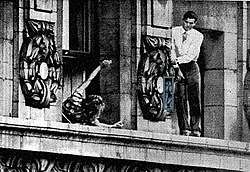John William Warde
John William Warde was a twenty-six-year-old former bank clerk from Southampton, New York who committed suicide on Tuesday, July 26, 1938. He leaped from a window ledge of the seventeenth floor of the Gotham Hotel at 5th Avenue and 55th Street[1] in Manhattan. The son of a Long Island express agent, his fourteen-hour dilemma before jumping held 300 New York City Police Department officers at bay. They were afraid of making a move.
Background
John William Warde worked as a bank clerk in Southampton until he survived a suicide attempt with a knife in July 1937 and spent three months in the Central Islip Psychiatric Center. A note on the discharge papers of the asylum in November 1937 declared:
The patient's manic-depressive psychosis seems to have arrested itself.
Eight days before his suicide, Warde was observed on a bridge outside Hampton Bays, New York staring over the edge into the water. A bridge tender chased him off and contacted the authorities, giving them Warde's license plate number. The police checked on him at his home and spoke with him.
On Tuesday morning the 26th of July, 1938, after spending a long weekend in Chicago, John William Warde, his sister Katherine and two friends of the family, Mr. and Mrs. Valentine, went to the room 1714 on the seventeenth floor of the Gotham Hotel. During a conversation his sister suggested making an appointment at a psychiatrist for him, which apparently upset him.[2] He dashed for a window and then occupied the ledge,[3] balancing there[4] from morning until late in the evening.
Chronology of death

Four hundred police officers and NYPD personnel responded to the emergency together with members of the Fire Department and volunteer helpers. Psychiatrist J. C. Presner was called by hotel management to make a plea to Warde, who was believed to be clinically depressed. Presner dropped tablets in the water which was being handed to Warde, which he hoped would help a person suffering from melancholia. Unfortunately the medicine did not work.[3]
Policeman Charles V. Glasco of Woodhaven, Queens was directing traffic near the hotel when the incident began to unfold. Immediately wanting to help, Glasco decided to pose as a civilian and then talk with Warde. Donning a bellhop uniform he borrowed from a bellboy in the lobby, Glasco entered Room 1714 and attempted to persuade Warde not to jump by talking to him on and off for 14 hours. They discussed baseball, ping pong, the merits of night versus day picnics, and other subjects. Glasco told Warde that this was his first day on the new job, and that if he jumped, it would be bad for business and the hotel would have to fire him. Glasco brought Warde glasses of water and cigarettes, hoping to get close enough to grab him.[5][6] Warde had disclosed a secret to Glasco during their time together. Glasco never revealed this secret to anyone and it is unknown what the secret was. Eventually, Glasco had convinced Warde to come off of the ledge. As Warde was exiting the ledge and re-entering the hotel, a photographer attempted to photograph Warde, causing him to jump off of the ledge.
Warde leaped feet first at 10:38 P.M., crashing into the glass marquee of the 55th Street entrance of the Gotham Hotel. His body smashed to the sidewalk. When he jumped, 10,000 people were gathered at the busy intersection of 55th Street and Fifth Avenue. Collectively they shouted "Here he comes!" before becoming silent at the moment Warde made his plunge.[3]
Burial
Warde was buried in Cemetery of the Evergreens, Brooklyn following a private funeral service at the New York and Brooklyn Funeral Home, located at 187 South Oxford Street in Brooklyn. His parents and two friends were present at the service. The service was pushed ahead four hours from a previously arranged time so as to avoid crowds.[7]
Warde's father, John A. Warde, was found vacationing in Vermont. The family home where he and Warde's mother resided was located at 25 Willow Street, Southampton.[5]
Film adaptation
Writer Joel Sayre wrote about the Warde suicide in The New Yorker in an article entitled "That Was New York: The Man on the Ledge," published on April 16, 1949. The story was purchased by Twentieth Century Fox.[8]
The Sayre article was adapted by Fox into the 1951 film Fourteen Hours, with Richard Basehart as the man on the ledge and Paul Douglas as the police officer who tries to talk him out of jumping. As originally shot, the film ended as in reality, with the man jumping to his death. After a preview, this was changed to end with his falling accidentally and grabbing the net to save his life.
The studio changed the title from The Man on the Ledge to Fourteen Hours at the request of Warde's mother, so that the picture would not be as closely identified with her son. Studio chief Darryl F. Zanuck considered changing the setting of the movie to another city for the same reason, but it was ultimately filmed in New York.[9] Various details about Officer Glasco's life were also fictionalized in the film.
References
- New York Times Gotham Hotel, now Peninsula New York
- "Fourteen Hours". Project Woodhaven. February 2010 (Woodhaven, Queens). (PDF). Retrieved November 14, 2019.
- Window Ledge Sitter Leaps To Death, A Century of Journalism, New York Post, Volume III, pp. 62 - 72.
- Is Life Worth Living?, New York Times, July 28, 1938, pg. 18.
- Throngs in 5th Ave. View Scene of Leap, New York Times, July 28, 1938, pg. 4.
- Woodhaven cop in daring high-rise drama http://archive.queenscourier.com/wp-content/digital-editions/RT02042016/index.html#/22/%5B%5D
- Warde Burial Advanced, New York Times, July 30, 1938, pg. 28.
- Smith, Richard Harland. "Fourteen Hours". TCM website. Turner Classic Movies. Retrieved 2009-03-22.
- "Notes for Fourteen Hours (1951)". Turner Classic Movies. Retrieved 2009-03-21.